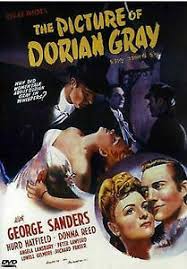
“I always choose my friends for their good looks and my enemies for their good intellect.”
Lord Henry Wotton (George Sanders) is a sociopath whose only real pleasure in life is in inflicting subtle influence on those around him. Especially those who are naïve. Dorian Gray (Hurd Hatfield) is such a person. Dorian is posing to have his picture painted by Basil Hallward (Lowell Gilmore) when he meets the manipulative Wotton. Wotton is both charming and at the same time cynical. The oily Lord lectures to Gray that life should be dedicated to pleasure. He tells him that his youth and beauty will bring him everything he desires. He says the only way to deal with a temptation is to yield to it. Dorian is caught up in Wonton’s flattery and his flowery words. While staring at his picture he wishes his portrait could age instead of him. He makes the wish openly in the presence of a statue of an Egyptian cat that is said to possess mystical powers to grant wishes. Wotton slowly begins to corrupt the young Dorian.
One night Dorian goes to a place called the Two Turtles in a poor neighborhood of Victorian London. There he meets and falls in love with a singer named Sibyl Vane (Angela Landsbury). When he tells Wotton that he plans to marry Sibyl, Wotton convinces him that he should test Sibyl’s honor. In other words try to talk her into having sex with him. If she does than she is not worthy. After much pressure she relents. Dorian then leaves Sibyl a note of dismissal and some money for her services. Dorian then travels abroad. When he returns he finds that Sibyl has committed suicide.
Dorian begins a life of debauchery. As the years pass Dorian’s friends grow old, but he does not. The painting, however, begins to change. All the evil that has infested Dorian’s soul is now reflected in the painting. It changes and the portrait grows old and evil looking, while the corrupt body of Dorian does not.
“The Picture of Dorian Gray” was released in 1945 and was directed by Albert Lewin. It is a film noir and is based on a story by Oscar Wilde. The narrator in the movie is Cedric Hardwicke. The portrait is the only thing in the movie that is in color. Henrique Medina painted the original picture used in the film, and Ivan Le Lorraine Albright painted the aged and ugly picture, which is shown in both black and white and color. When Dorian stands in front of both the portrait and the cat god he wishes to stay young. His wish comes true, however, the picture is not only aging but it is growing ugly. It is not only absorbing Dorian’s age but his sins as well.
Someone once compared “The Picture of Dorian Gray” to “Dr. Jekyll and Mr. Hyde”. It’s an interesting concept that has a lot of merit to it. Jekyll uses a potion to release Mr. Hyde. His opposite that he can blame all his sins on. It is a way to divert responsibility for his own actions by blaming them on his alternate self. The “evil twin” defense. Dorian does something similar in that he remains pure even while his actions are sinful. It is his portrait that appears to be the sinful one.
A similar view can be expanded on the Victorian Age as well. Outwardly everything is prim and proper. Everyone’s words are ultra polite and civil, however, underneath there is a teeming sinful underbelly where sex and violence explodes as if it can no longer be contained by the formal and constraining outward façade.

